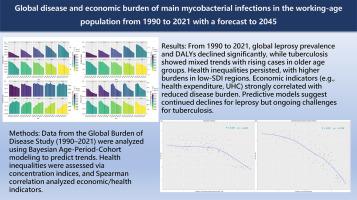Global disease and economic burden of main mycobacterial infections in the working-age population from 1990 to 2021 with a forecast to 2045
引用次数: 0
Abstract
Background
Mycobacterial infections such as tuberculosis and leprosy pose significant global health challenges, particularly in impoverished regions. These diseases not only cause severe physical symptoms but also lead to psychological and economic burdens. This study assesses the disease and economic burden of these infections among the global working-age population (15–64 years), identifies influencing factors, and predicts trends until 2045 to guide targeted interventions.
Methods
Using data from the Global Burden of Disease Study (1990–2021), age-standardized prevalence rates and disability-adjusted life years were analyzed for tuberculosis and leprosy. Predictive trends were modeled using the Bayesian age–period–cohort framework, and health inequalities were evaluated using concentration indices. Spearman correlation analysis was used to examine associations with economic and health indicators in the World Bank database.
Results
The prevalence of leprosy declined globally (from 14.426/100,000 to 5.942/100,000), and further reductions were projected. Tuberculosis trends were more complex, with potential increases observed in some age groups. Health inequalities persisted, particularly for leprosy, with higher burdens in low-income regions than high-income regions (concentration index: −0.35). Economic factors such as health expenditure (Spearman's rank correlation coefficient, ρ = −0.557) and universal health coverage (ρ = −0.785) were strongly correlated with disease burden.
Conclusions
Although the burden of mycobacterial infection decreased, disparities remained—especially for tuberculosis. Increased public health investment and targeted strategies are essential for mitigating these inequities and their socioeconomic impact.

1990年至2021年工作年龄人口中主要分枝杆菌感染的全球疾病和经济负担,并预测到2045年
结核和麻风病等分枝杆菌感染构成重大的全球卫生挑战,特别是在贫困地区。这些疾病不仅造成严重的身体症状,而且还造成心理和经济负担。本研究评估了全球工作年龄人口(15-64岁)中这些感染的疾病和经济负担,确定了影响因素,并预测了到2045年的趋势,以指导有针对性的干预措施。方法使用全球疾病负担研究(1990-2021)的数据,分析结核病和麻风病的年龄标准化患病率和残疾调整生命年。使用贝叶斯年龄-时期-队列框架对预测趋势进行建模,并使用浓度指数评估健康不平等。使用Spearman相关分析来检查与世界银行数据库中经济和健康指标的关联。结果麻风病全球患病率从14.426/10万下降到5.942/10万,预计将进一步下降。结核病的趋势更为复杂,在某些年龄组中观察到潜在的增加。卫生不平等现象持续存在,特别是麻风病,低收入地区的负担高于高收入地区(集中指数:- 0.35)。经济因素如卫生支出(Spearman等级相关系数,ρ =−0.557)和全民健康覆盖(ρ =−0.785)与疾病负担密切相关。结论结核分枝杆菌感染负担虽有所下降,但仍存在差异,尤其是结核病。增加公共卫生投资和有针对性的战略对于减轻这些不平等及其社会经济影响至关重要。
本文章由计算机程序翻译,如有差异,请以英文原文为准。
求助全文
约1分钟内获得全文
求助全文

 求助内容:
求助内容: 应助结果提醒方式:
应助结果提醒方式:


